MAP News Issue #581 – Sept 23, 2023
The MAP News | |
Electric blue tarantula discovered in a Thai mangrove forest  THAILAND – Researchers unearthed a new species of tarantula exhibiting a vibrant electric blue coloration, nestled within the enigmatic landscapes of Thailand’s mangrove forests. This exciting discovery unfolded in the Phang-Nga province and is the inaugural record of a tarantula species dwelling in Thai mangrove ecosystems. Dr. Narin Chomphuphuang and his research ensemble, accompanied by local wildlife aficionado and YouTuber JoCho Sippawat, embarked on this trailblazing expedition following the revelation of Taksinus bambus — the first tarantula known to inhabit bamboo stalks, in Thailand. Their quest was driven by the zeal to delve deeper into the secretive world of these arachnids. The distinctive electric blue of the tarantula immediately distinguished it from its peers, its color acting as a beacon in the dense, dark green foliage. Narin explained, “The first specimen we found was on a tree in the mangrove forest. These tarantulas inhabit hollow trees, presenting a challenge in catching them, as one needs to climb trees and lure them out of complex hollows amidst humid and slippery conditions.” The expedition meticulously maneuvered through the terrain in the evenings and nocturnal hours during low tide, overcoming obstacles to collect two specimens, showcasing the tarantula’s elusive nature. The electric blue tarantula, it was discovered, doesn’t owe its striking coloration to pigments, but rather to the intricate nanostructures within their hair, manipulating light to craft the illustrious blue hue, sometimes revealing an enchanting violet tint, creating a mesmerizing iridescent effect. THAILAND – Researchers unearthed a new species of tarantula exhibiting a vibrant electric blue coloration, nestled within the enigmatic landscapes of Thailand’s mangrove forests. This exciting discovery unfolded in the Phang-Nga province and is the inaugural record of a tarantula species dwelling in Thai mangrove ecosystems. Dr. Narin Chomphuphuang and his research ensemble, accompanied by local wildlife aficionado and YouTuber JoCho Sippawat, embarked on this trailblazing expedition following the revelation of Taksinus bambus — the first tarantula known to inhabit bamboo stalks, in Thailand. Their quest was driven by the zeal to delve deeper into the secretive world of these arachnids. The distinctive electric blue of the tarantula immediately distinguished it from its peers, its color acting as a beacon in the dense, dark green foliage. Narin explained, “The first specimen we found was on a tree in the mangrove forest. These tarantulas inhabit hollow trees, presenting a challenge in catching them, as one needs to climb trees and lure them out of complex hollows amidst humid and slippery conditions.” The expedition meticulously maneuvered through the terrain in the evenings and nocturnal hours during low tide, overcoming obstacles to collect two specimens, showcasing the tarantula’s elusive nature. The electric blue tarantula, it was discovered, doesn’t owe its striking coloration to pigments, but rather to the intricate nanostructures within their hair, manipulating light to craft the illustrious blue hue, sometimes revealing an enchanting violet tint, creating a mesmerizing iridescent effect. GLOBAL Mangroves: Our Allies Against Climate Change 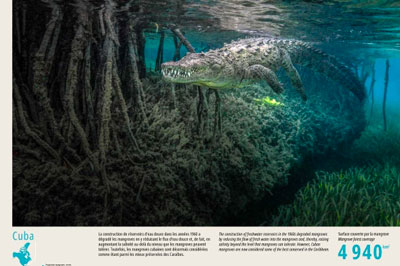 GLOBAL – Have you ever wondered why people consider mangrove forests to be our allies against climate change? Do you know whether your country has mangroves and how much land these cover? A new exhibition sets out to answer these and other questions. A series of 125 posters combine stunning photos with interesting facts and figures on the mangroves of the world. These posters will be visible on the railings that surround UNESCO headquarters in Paris until the end of September 2023. This photo exhibition takes us on a world tour, since there is a poster for every country in the world that has natural mangrove stands, as well as some of their overseas territories. Mangroves occupy the boundary between land and sea. At a time when sea levels are rising as a consequence of climate change, mangrove forests are of particular interest to scientists, since they are able to thrive in relatively saline soils. Mangroves are widespread, growing in sheltered lagoons and deltas in the tropics and subtropics in the Americas, Africa, the Middle East, Asia and the Pacific. The Sundarbans, which straddles Bangladesh and India, is the world’s largest stand-alone mangrove forest. Mangrove forests sustain local communities by providing them with seafood, wood and other products. They also mitigate the impact of climate change by sequestering carbon and protecting the coast from storm surges. GLOBAL – Have you ever wondered why people consider mangrove forests to be our allies against climate change? Do you know whether your country has mangroves and how much land these cover? A new exhibition sets out to answer these and other questions. A series of 125 posters combine stunning photos with interesting facts and figures on the mangroves of the world. These posters will be visible on the railings that surround UNESCO headquarters in Paris until the end of September 2023. This photo exhibition takes us on a world tour, since there is a poster for every country in the world that has natural mangrove stands, as well as some of their overseas territories. Mangroves occupy the boundary between land and sea. At a time when sea levels are rising as a consequence of climate change, mangrove forests are of particular interest to scientists, since they are able to thrive in relatively saline soils. Mangroves are widespread, growing in sheltered lagoons and deltas in the tropics and subtropics in the Americas, Africa, the Middle East, Asia and the Pacific. The Sundarbans, which straddles Bangladesh and India, is the world’s largest stand-alone mangrove forest. Mangrove forests sustain local communities by providing them with seafood, wood and other products. They also mitigate the impact of climate change by sequestering carbon and protecting the coast from storm surges. History happens now: A teen environmentalist provides a glimpse inside the UN General Assembly 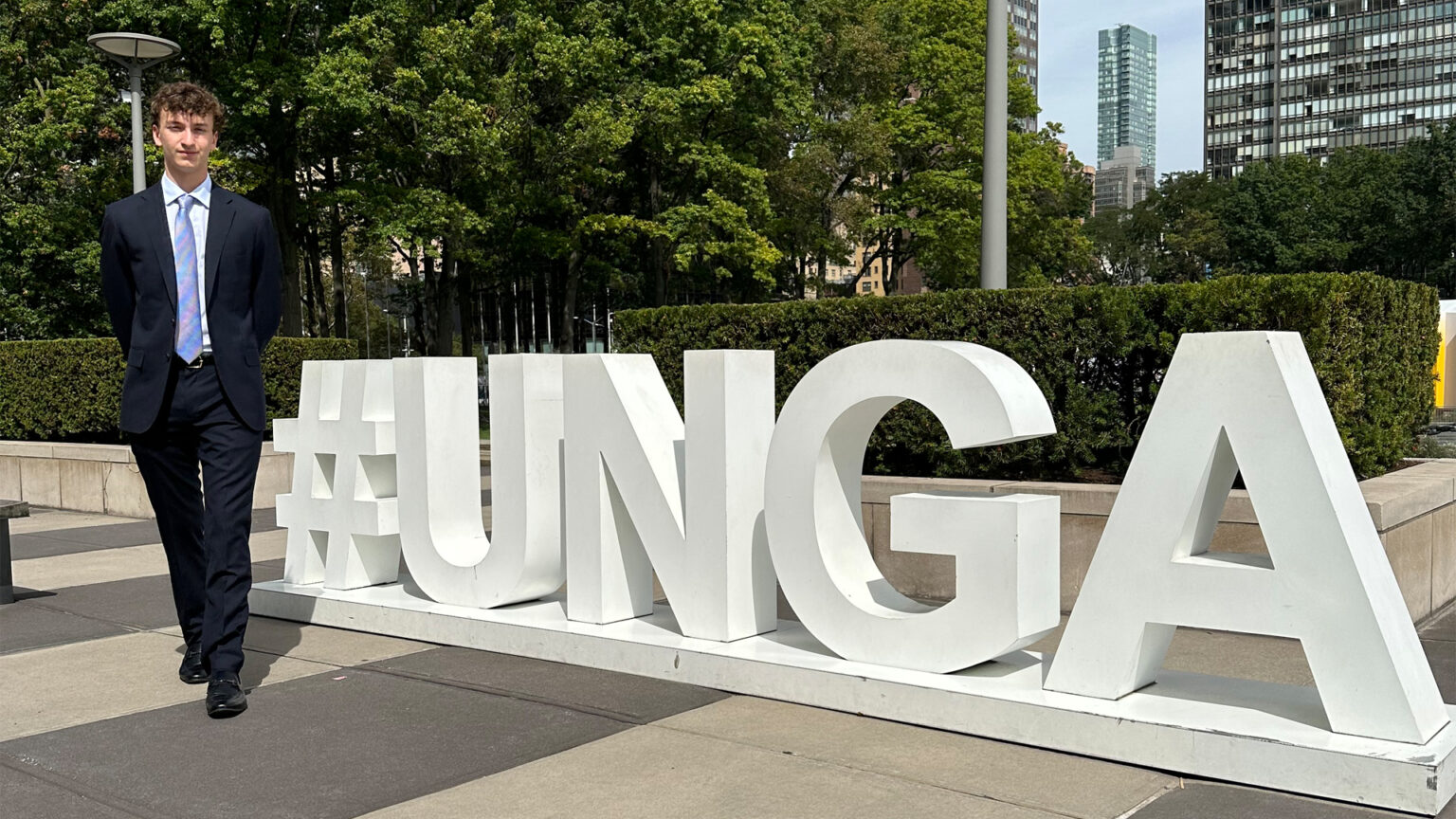 UNITED NATIONS – “Climate collapse has begun.” With these ominous words, United Nations Secretary-General António Guterres kicked off this year’s U.N. General Assembly at the U.N. headquarters in New York City. Guterres’ opening press conference, following blistering summer heatwaves that shattered temperature records on virtually every continent on Earth, was meant to spark urgency among the world’s decision-makers. Reminding his compatriots that “climate change is here,” Guterres said: “It is terrifying. And it is just the beginning.” It is with this warning in mind that, as my own flight landed in New York, I pondered my purpose. I was set to speak with a panel of youth on our hopes for the outcome of this pivotal assembly. For those who’ve followed my journey as a teen environmentalist, you’re familiar with my optimism. And while some might label my hopefulness as naivete or downright delusion, for so long as one mangrove survives the heat in our warming city, I’ll continue in my refusal to see my world through a bleak lens and keep pursuing my lofty goal to halt climate change. Because to do anything less ensures an unthinkable ending. But to borrow the words of American journalist David Wallace-Wells, “It’s time to panic.” Guterres’ goal as the General Assembly picks up speed over the next few days is for the 193 member states to commit to take enough action to catch up on the lagging sustainable development goals that will ensure our very survival. The 17 sustainable development goals, known as the SDGs, were entered into voluntarily by all nations in 2015 and are considered essential to achieve by 2030 to ensure a sustainable future for us all. UNITED NATIONS – “Climate collapse has begun.” With these ominous words, United Nations Secretary-General António Guterres kicked off this year’s U.N. General Assembly at the U.N. headquarters in New York City. Guterres’ opening press conference, following blistering summer heatwaves that shattered temperature records on virtually every continent on Earth, was meant to spark urgency among the world’s decision-makers. Reminding his compatriots that “climate change is here,” Guterres said: “It is terrifying. And it is just the beginning.” It is with this warning in mind that, as my own flight landed in New York, I pondered my purpose. I was set to speak with a panel of youth on our hopes for the outcome of this pivotal assembly. For those who’ve followed my journey as a teen environmentalist, you’re familiar with my optimism. And while some might label my hopefulness as naivete or downright delusion, for so long as one mangrove survives the heat in our warming city, I’ll continue in my refusal to see my world through a bleak lens and keep pursuing my lofty goal to halt climate change. Because to do anything less ensures an unthinkable ending. But to borrow the words of American journalist David Wallace-Wells, “It’s time to panic.” Guterres’ goal as the General Assembly picks up speed over the next few days is for the 193 member states to commit to take enough action to catch up on the lagging sustainable development goals that will ensure our very survival. The 17 sustainable development goals, known as the SDGs, were entered into voluntarily by all nations in 2015 and are considered essential to achieve by 2030 to ensure a sustainable future for us all.AFRICA Africa seeks united front on climate
The Great Blue Wall to rescue Africa’s sea life  KENYA – Rising sea levels, high ocean temperatures, cyclones, floods, and increased seawater salination have caused the continent loss of lives and livelihoods, hunger, malnutrition, loss of property, and human displacement every year, especially hitting the continent’s coastal communities. In recognising the urgent need for action to counter these effects of climate change, the Great Blue Wall (GBW), an initiative that has been at the forefront of fostering Africa’s blue economy, climate adaptation and resilience, was born at COP 26 in 2021 in Glasgow, Scotland. Western Indian Ocean (WIO) states comprise the Eastern African coastal nations of Somalia, Kenya, Tanzania, Mozambique, South Africa, as well as the island states of Comoros, Madagascar, Mauritius, Seychelles and the overseas French territories of Mayotte and Reunion. These nations, in partnership with the International Union for Conservation of Nature (IUCN) launched the GBW as a network of marine and coastal conserved areas to benefit biodiversity and local livelihoods and empower communities to become stewards of the ocean. It is a movement that was basically launched to conserve and restore marine and coastal biodiversity while harnessing the development of a regenerative sustainable blue economy. This supports an abundance of marine life including important fish species, sharks and rays, turtles, sea birds, and marine mammals. KENYA – Rising sea levels, high ocean temperatures, cyclones, floods, and increased seawater salination have caused the continent loss of lives and livelihoods, hunger, malnutrition, loss of property, and human displacement every year, especially hitting the continent’s coastal communities. In recognising the urgent need for action to counter these effects of climate change, the Great Blue Wall (GBW), an initiative that has been at the forefront of fostering Africa’s blue economy, climate adaptation and resilience, was born at COP 26 in 2021 in Glasgow, Scotland. Western Indian Ocean (WIO) states comprise the Eastern African coastal nations of Somalia, Kenya, Tanzania, Mozambique, South Africa, as well as the island states of Comoros, Madagascar, Mauritius, Seychelles and the overseas French territories of Mayotte and Reunion. These nations, in partnership with the International Union for Conservation of Nature (IUCN) launched the GBW as a network of marine and coastal conserved areas to benefit biodiversity and local livelihoods and empower communities to become stewards of the ocean. It is a movement that was basically launched to conserve and restore marine and coastal biodiversity while harnessing the development of a regenerative sustainable blue economy. This supports an abundance of marine life including important fish species, sharks and rays, turtles, sea birds, and marine mammals.
AMERICAS Indigenous-Led Education Network named winner of the Inclusive Global Environmental Facility Challenge to save the Rainforest  CANADA – At the Seventh Assembly of the Global Environmental Facility (GEF) in Vancouver, British Columbia, the Indigenous-Led Education Network (ILED), a dynamic collaborative network of indigenous-led education initiatives from across several nations, was one of 23 proud winners of the GEF Inclusive Challenge Program. This acknowledgment continues a wave of international recognition of the valuable role of indigenous communities in looking after our planet’s most vital ecosystems and the importance of support for innovative, grassroots approaches to a more sustainable future. The Challenge seeks to support and elevate community-driven climate and nature projects and the unique contributions of indigenous peoples, women, girls, and young people to pressing global environmental challenges. The establishment of the UN Inclusive GEF Challenge fund and the recognition of ILED’s accomplishments is an acknowledgment of the pivotal role that indigenous youth and their knowledge play in safeguarding tropical rainforests and combating climate change. ILED, supported by the Rutu Foundation, is a network of grassroots, indigenous-led organizations across Africa, Latin America and Asia aimed at passing on their environmental wisdom to the next generations. CANADA – At the Seventh Assembly of the Global Environmental Facility (GEF) in Vancouver, British Columbia, the Indigenous-Led Education Network (ILED), a dynamic collaborative network of indigenous-led education initiatives from across several nations, was one of 23 proud winners of the GEF Inclusive Challenge Program. This acknowledgment continues a wave of international recognition of the valuable role of indigenous communities in looking after our planet’s most vital ecosystems and the importance of support for innovative, grassroots approaches to a more sustainable future. The Challenge seeks to support and elevate community-driven climate and nature projects and the unique contributions of indigenous peoples, women, girls, and young people to pressing global environmental challenges. The establishment of the UN Inclusive GEF Challenge fund and the recognition of ILED’s accomplishments is an acknowledgment of the pivotal role that indigenous youth and their knowledge play in safeguarding tropical rainforests and combating climate change. ILED, supported by the Rutu Foundation, is a network of grassroots, indigenous-led organizations across Africa, Latin America and Asia aimed at passing on their environmental wisdom to the next generations.
ASIA Mannar, Chilaw shrimp farms face scrutiny over effluents  SRI LANKA – After a recent field study found that a majority of shrimp and aquaculture farms across the country have failed to comply with environmental regulations, the Fisheries Ministry directed relevant government agencies, the National Aquatic Culture Development Authority (NAQDA) and the National Aquatic Resources Development and Research Agency (NARA) to take immediate legal action against those farms. “Take legal action against all the shrimp farms in Mannar and Chilaw areas that don’t release wastewater in a proper way,” Fisheries Minister Douglas Devananda directed senior officials at a meeting held last Friday to discuss issues regarding the mismanagement of shrimp farms in the North and North-Western provinces. While stressing the need to take legal action against those companies “irrespective of their status”, Mr. Devananda also directed officials to submit a report on action taken and take action against the NAQDA officials who did not fulfil their responsibility, according to a statement issued by the ministry on the meeting. A separate report has also been called on the measures taken against NAQDA officials who failed in their duties to ensure that shrimp farms adhered to environmental regulations. A recent field study carried out by relevant agencies found that of the 670 shrimp farms in the Chilaw and Puttalam areas, at least 273 lacked proper wastewater management plans. Mr. Devananda visited some of those farms recently and observed that it’s the responsibility of NAQDA and NARA to regularly monitor the farms’ wastewater management systems. SRI LANKA – After a recent field study found that a majority of shrimp and aquaculture farms across the country have failed to comply with environmental regulations, the Fisheries Ministry directed relevant government agencies, the National Aquatic Culture Development Authority (NAQDA) and the National Aquatic Resources Development and Research Agency (NARA) to take immediate legal action against those farms. “Take legal action against all the shrimp farms in Mannar and Chilaw areas that don’t release wastewater in a proper way,” Fisheries Minister Douglas Devananda directed senior officials at a meeting held last Friday to discuss issues regarding the mismanagement of shrimp farms in the North and North-Western provinces. While stressing the need to take legal action against those companies “irrespective of their status”, Mr. Devananda also directed officials to submit a report on action taken and take action against the NAQDA officials who did not fulfil their responsibility, according to a statement issued by the ministry on the meeting. A separate report has also been called on the measures taken against NAQDA officials who failed in their duties to ensure that shrimp farms adhered to environmental regulations. A recent field study carried out by relevant agencies found that of the 670 shrimp farms in the Chilaw and Puttalam areas, at least 273 lacked proper wastewater management plans. Mr. Devananda visited some of those farms recently and observed that it’s the responsibility of NAQDA and NARA to regularly monitor the farms’ wastewater management systems.Singapore’s first large-scale mangrove restoration project moves ahead 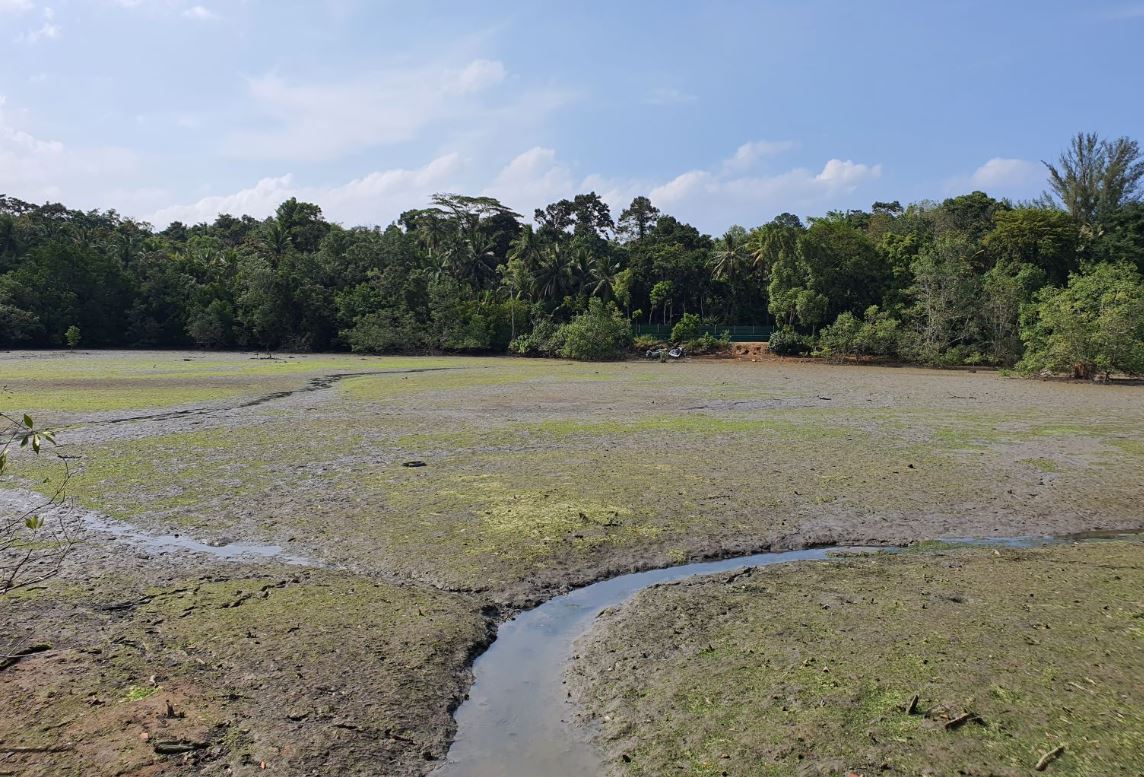 SINGAPORE – “Last year, we announced the establishment of the OCBC Mangrove Park at Sungei Durian ponds along the southern coast of Pulau Ubin, the first large-scale Ecological Mangrove Restoration project in Singapore,” said Nparks. Site preparation will commence in 2024, which include earth-filling to raise the elevation of the pond beds, improving hydrology, and maximising sediment retention. With this, an estimated 8,000 mangrove plants are expected to naturally establish at the site. “Ahead of this, we engaged academics, the nature community and Friends of Ubin Network (FUN) to discuss the design concept and findings of the Environmental Impact Assessment (EIA) which studied the potential impacts of the proposed works on the environment,” NParks said. The study concluded that the proposed works would not cause significant environmental impacts with the use of silt curtains and silt fences as mitigation measures. SINGAPORE – “Last year, we announced the establishment of the OCBC Mangrove Park at Sungei Durian ponds along the southern coast of Pulau Ubin, the first large-scale Ecological Mangrove Restoration project in Singapore,” said Nparks. Site preparation will commence in 2024, which include earth-filling to raise the elevation of the pond beds, improving hydrology, and maximising sediment retention. With this, an estimated 8,000 mangrove plants are expected to naturally establish at the site. “Ahead of this, we engaged academics, the nature community and Friends of Ubin Network (FUN) to discuss the design concept and findings of the Environmental Impact Assessment (EIA) which studied the potential impacts of the proposed works on the environment,” NParks said. The study concluded that the proposed works would not cause significant environmental impacts with the use of silt curtains and silt fences as mitigation measures.Fishermen’s woes: 350 families deprived of food aid for 8 year 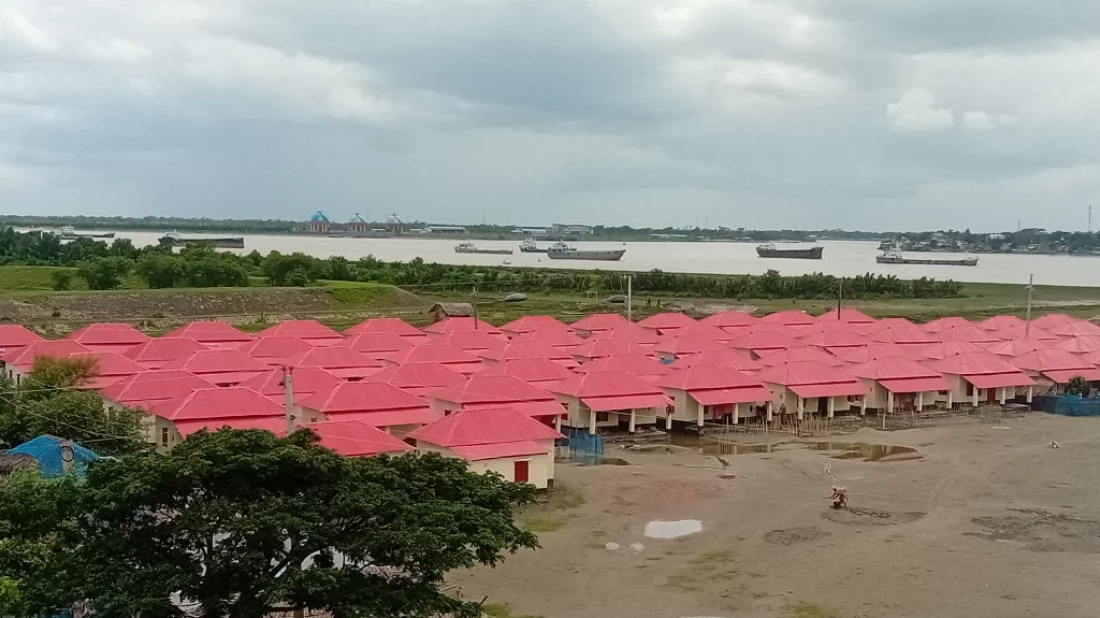 INDIA – Ershad Ali Ghazi, a fisherman in Kaibaddasakathi Char in Bagerhat’s Rampal, was registered under the Fisheries Department for food aid eight years ago when he was given a card. Using such cards, the enlisted fishermen are supposed to collect 30 kgs of rice twice a year when the government enforces a ban on fishing in the sea, rivers and the Sundarbans to ensure a safe breeding ground for fish. Ershad Ali says fishing is his sole source of income. Therefore, earning money to buy daily necessities and bear other expenses for his family of five members often seems impossible during the ban as he has to work as a farmer or as a daily wage-earner. During a recent visit to the area, the Dhaka Tribune correspondent discovered that Ershad is among around 350 fishermen living in the char areas of Gourambha Union who have never received any government food assistance in the last 8-11 years. Despite that, Ershad was preparing for the new season as the 65-day ban on fishing in the sea was lifted on July 23. The livelihood of the fishermen is hampered when the government enforces a three-month ban on entry into the Sundarbans mangrove forest from June 1-August 31. Moreover, these fishermen depend on sea resources during the ban on fishing in the rivers in the ilish season in March-April and three weeks in October. INDIA – Ershad Ali Ghazi, a fisherman in Kaibaddasakathi Char in Bagerhat’s Rampal, was registered under the Fisheries Department for food aid eight years ago when he was given a card. Using such cards, the enlisted fishermen are supposed to collect 30 kgs of rice twice a year when the government enforces a ban on fishing in the sea, rivers and the Sundarbans to ensure a safe breeding ground for fish. Ershad Ali says fishing is his sole source of income. Therefore, earning money to buy daily necessities and bear other expenses for his family of five members often seems impossible during the ban as he has to work as a farmer or as a daily wage-earner. During a recent visit to the area, the Dhaka Tribune correspondent discovered that Ershad is among around 350 fishermen living in the char areas of Gourambha Union who have never received any government food assistance in the last 8-11 years. Despite that, Ershad was preparing for the new season as the 65-day ban on fishing in the sea was lifted on July 23. The livelihood of the fishermen is hampered when the government enforces a three-month ban on entry into the Sundarbans mangrove forest from June 1-August 31. Moreover, these fishermen depend on sea resources during the ban on fishing in the rivers in the ilish season in March-April and three weeks in October. Pease consider donating to MAP to keep it going. *Articles in this newsletter may mention practices being used and/or show exagerated results being claimed without proof. Stories are presented here in effort to show mangrove related activity around the world and do not necessarily reflect Mangrove Action Project’s views or mangrove restoration best-practices. ACTION ALERTSEcuador: Stop land grabbing and racial discrimination for palm oil! SIGN THE PETITIONUGANDA Stop criminalizing pipeline protesters! SIGN THE PETITIONSave Endangered Species From SpaceX | |
Mangrove Action Project Click here to view past newsletters
| |

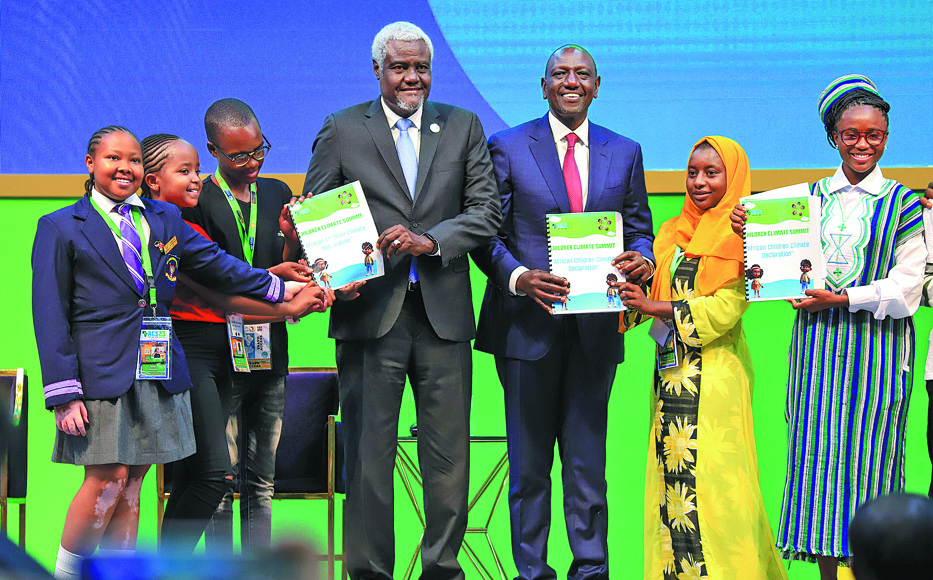 WESTERN AFRICA – “Africa is nature’s superpower, hosting a quarter of global biodiversity. Congo Forest is one of the lungs of the earth and captures a lot of carbon. Niger Delta is one of the largest mangroves in Africa,” said Muhtari Aminu-Kano, policy and government relations director for Africa region at The Nature Conservancy. Though Africa expects developed countries to honor their annual pledges for climate action in developing countries, experts are of the view that the continent should leverage its vast resource potential and technology to fight climate change as the crisis continues to worsen. At the end of the three-day Africa Climate Summit in the Kenyan capital Nairobi, African leaders issued the Nairobi Declaration, which urged developed nations to honor their commitments to provide $100 billion in annual climate finance for the continent. The declaration also calls for a new financing architecture that is responsive to Africa’s needs, including debt restructuring and relief. In addition to developing a new Global Climate Finance Charter through the United Nations General Assembly and Conference of the Parties to the UN Framework Convention on Climate Change by 2025, leaders at the summit also resolved to promote sustainable utilization of Africa’s natural assets for the continent’s progression toward low-carbon development. According to the UN, Africa holds 25 percent of the world’s biodiversity, 10 percent of internal renewable fresh water, the largest reserves of cobalt, diamonds, platinum and uranium, and has the second-largest carbon sink.
WESTERN AFRICA – “Africa is nature’s superpower, hosting a quarter of global biodiversity. Congo Forest is one of the lungs of the earth and captures a lot of carbon. Niger Delta is one of the largest mangroves in Africa,” said Muhtari Aminu-Kano, policy and government relations director for Africa region at The Nature Conservancy. Though Africa expects developed countries to honor their annual pledges for climate action in developing countries, experts are of the view that the continent should leverage its vast resource potential and technology to fight climate change as the crisis continues to worsen. At the end of the three-day Africa Climate Summit in the Kenyan capital Nairobi, African leaders issued the Nairobi Declaration, which urged developed nations to honor their commitments to provide $100 billion in annual climate finance for the continent. The declaration also calls for a new financing architecture that is responsive to Africa’s needs, including debt restructuring and relief. In addition to developing a new Global Climate Finance Charter through the United Nations General Assembly and Conference of the Parties to the UN Framework Convention on Climate Change by 2025, leaders at the summit also resolved to promote sustainable utilization of Africa’s natural assets for the continent’s progression toward low-carbon development. According to the UN, Africa holds 25 percent of the world’s biodiversity, 10 percent of internal renewable fresh water, the largest reserves of cobalt, diamonds, platinum and uranium, and has the second-largest carbon sink.






